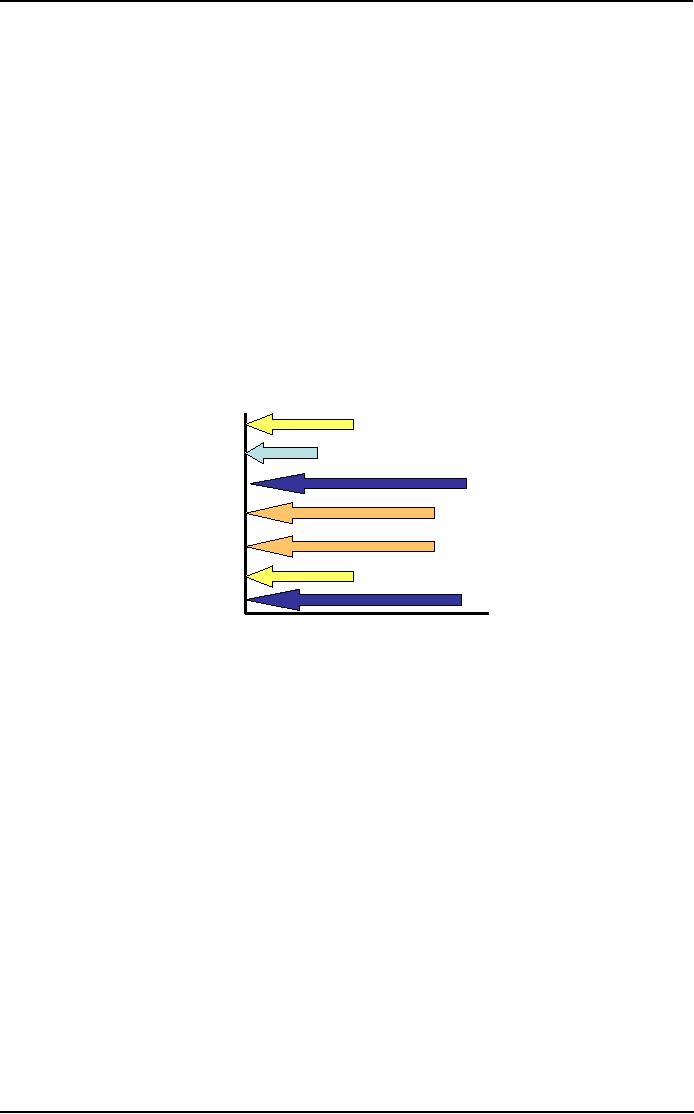 |

Leadership
& Team Management MGMT
623
VU
Lecture
29
DECISION
MAKING
Decision
Making and Decision Making
Process:
A
decision
is
a choice made from two or more
alternatives. The decision-making
process is
recognizing
and defining the nature of a decision
situation, identifying alternatives,
choosing the "best"
alternative,
and putting it into practice. An
effective decision is one that
optimizes some set of
factors
such
as profits, sales, employee
welfare, and market share.
Managers make decisions about
both
problems
and opportunities.
Problem
Solving Vs Decision
Making
Problem
solving: finding the root
cause of a deviation (cause
analysis)
o
Decision
making: choosing from alternative
courses of action (choice
analysis)
o
Problem
solving --------------- Decision
making
Categories
of Decisions
�
Technical
�
Emotional
�
Communication
�
Budget
�
Ethical
�
Personnel
�
Career
Relative
Importance
Types
of Decisions:
Programmed
Decisions: A decision
that is a fairly structured decision or
recurs with some
frequency
or
both. Example: Starting your
car in the morning.
Non-programmed
decisions: A decision
that is relatively unstructured and
occurs much less often
than
a
programmed decision. Example: Choosing a
vacation destination.
Intuitive
decision making: Managers
also regularly use their
intuition. Intuitive decision
making is a
subconscious
process of making decisions on the basis
of experience and accumulated Judgment.
Making
decisions on the basis of gut feeling
doesn't necessarily happen independently of
rational
o
analysis;
the two complement each
other.
Although
intuitive decision making
will not replace the rational
decision-making process, it
does
o
play
an important role in managerial
decision making
Decision-Making
Conditions
Decision
Making Under
Certainty
o
122

Leadership
& Team Management MGMT
623
VU
o
A
condition in which the decision maker
knows with reasonable
certainty what the
alternatives
are and what conditions
are associated with each
alternative. A situation in
which
a manager can make accurate
decisions because all outcomes
are known. Few
managerial
decisions are made under the
condition of certainty.
Decision
Making Under Risk
o
o
A
condition in which the availability of
each alternative and its
potential payoffs and
costs
are
all associated with
risks.
Decision
Making Under
Uncertainty
o
A
condition in which the decision maker
does not know all the
alternatives, the risks
o
associated
with each, or the consequences of
each alternative. Uncertainty is a
situation in
which
the decision maker is not certain
and cannot even make reasonable
probability
estimates
concerning outcomes of
alternatives.
The
choice of alternative is influenced by the
limited amount of information
available
to the decision maker.
It's
also influenced by the psychological
orientation of the decision maker
The
Decision-Making Process:
Step
1: Identifying
a problem. A problem
is
a discrepancy between an existing and a desired
state of
affairs.
In order to identify a problem,
you as a manager/leader should recognize and
understand the
three
characteristics of problems:
o
You
must be aware of the problem. Be
sure to identify the actual problem
rather than a symptom of
the
problem.
o
You
must be under pressure to
act. A true problem puts
pressure on the manager to take
action; a
problem
without pressure to act is a
problem that can be
postponed.
o
You
must have the authority or resources to
act. When managers recognize a
problem and are under
pressure
to take action but do not
have necessary resources, they
usually feel that
unrealistic
demands
are being put upon
them.
Step
2: Identifying
decision criteria.
Decision
criteria are
criteria that define what is
relevant in a
decision.
Step
3: Allocating
weights to the criteria. The
criteria identified in Step 2 of
the decision-making
process
do not have equal importance, so the
decision maker must assign a
weight to each of the items
in
order to give each item
accurate priority in the
decision.
Step
4: Developing
alternatives. The
decision maker must now
identify viable
alternatives
that
could
resolve the problem.
Step
5: Analyzing
alternatives. Each of
the alternatives must now be
critically analyzed by evaluating
it
against the criteria established in Steps 2 and
3.
Step
6: Selecting
an alternative. This
step to select the best
alternative from among those
identified
and
assessed is critical. If criteria
weights have been used, the
decision maker simply selects
the
alternative
that received the highest
score in Step 5.
Step
7: Implementing
the alternative. The
selected alternative must be
implemented by effectively
communicating
the decision to the individuals who
will be affected by it and winning
their commitment
to
the decision.
Step
8: Evaluating
Results. This
last step in the decision-making process
assesses the result of the
decision
to determine whether or not the problem
has been resolved.
123

Leadership
& Team Management MGMT
623
VU
Evaluating
Alternatives in the Decision-Making
Process
Quantitative
and Qualitative Factors in Decision
Making:
Quantitative
Factors
o
Investment
appraisal
o
Break-even
analysis
o
Market
research
o
Sales
forecasting
o
Critical
path analysis
o
Decision
trees
Qualitative
Factors
o
Stakeholder
analysis
o
HRM
o
SWOT
The
Classical Model of Decision Making:
Classical
model is based on economic conditions
and
considered
to be normative. It relates to accomplishment of goals
that are known and agreed
upon. The
classical
model Strives for certainty
by gathering complete information. This
is also use as criteria
for
evaluating
alternatives that are
known.
Decision
Making Behavior:
Behavior
always varies person to person. People
tend to adopt a particular
decision making approach as
a
result of factors such
as;
o
Their
own personality
o
Their
current mood
o
The
organisational culture
o
The
personality of the person/people they are
dealing with
o
The
nature of the relationship they have with
the people they are dealing
with
o
Time
pressure and perceived level of
stress
Being
aware of these influences
can result in better
decision making, by adopting the
best decision
making
approach for each
situation.
Decision
Making Approaches:
o
Withdrawing:
holding
off making the
decision.
o
Smoothing:
focusing
on areas of agreement and
ignoring areas of
difference.
o
Compromising:
trying
to come up with a decision
that provides some degree of
satisfaction for
all
parties.
o
Confronting/problem
solving: working
through the issues.
o
Forcing:
executing
a particular decision knowing
agreement has not been
reached.
What
Kinds Of Decisions Do People
Make In The
Workplace?
o
Handling
complex problems individually
o
Handling
complex problems as a team
o
Focusing
effort
o
Judging
people
How
to Make Better
Decisions:
1.
Increase Your
Knowledge
o
Ask
questions.
o
Get
experience.
124

Leadership
& Team Management MGMT
623
VU
o
Use
consultants.
o
Do
your research.
o
Force
yourself to recognize the facts when
you see them (maintain your
objectivity).
2.
Use Your
Intuition
o
A
cognitive process whereby a
person instinctively makes a
decision based on his or
her
accumulated
knowledge and experience.
3.
Weigh the Pros and
Cons
o
Quantify
realities by sizing up your
options, and taking into
consideration the relative
importance
of each of your
objectives.
4.
Don't Overstress the
Finality of Your
Decision
o
Remember
that few decisions are
forever.
5.
Make Sure the Timing Is
Right
o
Decisions
always depend on the time.
Helpful
Hints:
Don't
Do
Clearly
identify the decision to be
Make
assumptions
o
o
made
Delay
o
Involve
people qualified to help in
the
Jump
to conclusions
o
o
decision
making
Make
uninformed decisions
o
Identify
the context of the decision
(the
Favour
one decision prior to
gathering
o
o
bigger
picture)
the
facts and evaluating the
alternatives
Identify
all alternatives
Allow
only technical people to
make
o
o
Assess
each alternative
the
decisions
o
Assess
the risks
Attempt
to make a decision in
isolation
o
o
Consider
your "gut feel"
of
the context
o
Make
the decision and stick to it
Let
emotion override
objectivity
o
o
Roadblocks
to Good Decision
Making
o
Human
Cognition
o
Our
mental ability to comprehend and understand
something
o
Human
Perception
o
Difficulty
isolating problems
o
Tend
to think of only narrow range of possible
solution
o
Human
Bias
o
Tendency
to shape responses based on
stereotypes, memory, and current
position
Decision-Making
and Technology: In today's
completive world Information
technology can also
help
and
support the decision-making. Different
decision making tools are
available for manager and
leaders
to
use in practical
life.
125
Table of Contents:
- INTRODUCTION, ORGANIZATION THE STAGE FOR LEADERSHIP:Challenges, Value creation
- FOCUSING ON PEOPLE: THE KEY TO SUCCESS:People in the Process, Developing and Sustaining A World-class Workforce
- LEADERSHIP:Characteristics of Successful Leader, Why Study Leadership?
- LEADERSHIP (CONTD.):Characteristics of Leaders Who Fail, Why Leaders Fail?
- MANAGERS VS LEADERS:Characteristics, Effective Leadership, Respect for Diversity
- FOLLOWER-SHIP:Importance of Followers, Follower-ship Style
- LEADERSHIP PROCESS:Strategies for Cultivating Exemplary Followers, Important Traits of Leaders
- LEADERSHIP PROCESS (CONTD.):Qualities of Leaders, Self-Confidence, Integrity
- LEADERSHIP THEORIES/ APPROACHES:Personal Characteristics of Leaders, Managerial Grid
- CONTINGENCY THEORIES OF LEADERSHIP:The Fiedler Model, Situational Leadership Theory, Path-Goal Theory
- TRANSACTIONAL, CHARISMATIC AND TRANSFORMATIONAL LEADERSHIP:Visionary Leadership
- THE LEADER AS AN INDIVIDUAL:Personality, Situation, Heredity, Environment
- ATTITUDE-PERSONALITY:Job Satisfaction, Work Situation, Self - Monitoring
- BIG FIVE MODEL, MYERS BRIGGS TYPE INDICATOR (MBTI):Sub-Categories Defined, Information Gathering
- SITUATIONAL FACTORS:Social and psychological climate, Culture of the organization
- BECOMING A LEADER! WHAT DOES IT MEAN & HOW DO YOU GET IT?:Mission Statement, Leading oneself
- BECOMING A LEADER:Elements of Leadership, CONCEPT OF POWER,
- UNDERSTANDING POWER:Sources of Power, Responses to the Use of Power, Managing Political Behavior
- LEADERSHIP POWER & INFLUENCE:Positional Power, Being an Effective Leader
- LEADERSHIP AND EMPOWERMENT:Power sharing and Empowerment, Share Information
- MOTIVATION:Guidelines for Delegating, Human Resource Approach
- MOTIVATION AT WORK, MOTIVATION AND LEADERSHIP:What Factors Diminish Motivation in the Workplace
- LEADERSHIP COMMUNICATION:Communication & the Four Management Functions
- REVIEW-1:Organizational Performance, That is the Role of Management?, Leaders Vs Managers
- GROUP & TEAM CONCEPT:Groups versus Teams, Deciding When to Use a Team
- TEAM DYNAMICS:Stages of Group Development, Problem-Solving Teams, Benefits of Teams
- BUILDING THE TEAM:Leadership success requires, Strategies for Team Building
- A TEAM-BASED ORGANIZATION:Basic Steps, Span of Control, Categories of Decisions
- DECISION MAKING:Categories of Decisions, The Decision-Making Process
- TEAM DECISION MAKING:Team Problem Solving Techniques, Concept of QC
- EFFECTIVE TEAM COMMUNICATION:Team/Group Communications
- CONFLICT IN TEAM:Sources of Conflict, Scarcity of Resources, Dysfunctional Outcomes
- TRAINING/LEARNING OF TEAM:Training Methods, Phases of Learning Cycles
- LEARNING ORGANIZATION:A Litmus Test, Work Relations
- REWARDING & RECOGNIZING TEAMWORK:Compensating Teams, Individual or Team Rewards?
- MANAGING/LEADING VIRTUAL TEAMS:Communications in Virtual Organizations, Virtual Leadership
- EFFECTIVE TEAM MEETINGS:Better Meetings, Meeting Roles, Meeting Room Facilities
- LEADING TEAM:Team Leadership Structures, Leadership Demands and Duties, Leadership Direction
- REVIEW-II:Types of Teams, Characteristics of High Performance Teams, Sources of Conflict
- STRATEGIC LEADERSHIP:Strategic Management, Determining Strategic Direction, Developing Human Capital:
- LEADING CHANGE:Dynamics of Change, Change Models, Unfreeze
- CREATIVE LEADERSHIP:Awaken Your Senses, How Might These Definitions Be Integrated
- ETHICS IN LEADERSHIP:Character Traits Reflect Ethics, Manifests Honesty
- LOOKING AT THE FUTURE: WHAT COMES NEXT:Benefits of Teams, Ethical Leadership,
- TEAMWORK: LEARNING FROM NATURE:Social Behavior, Termites, Learning from Nature